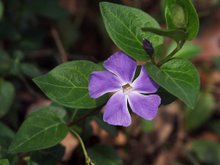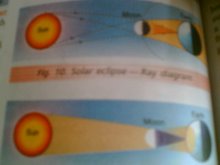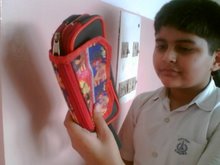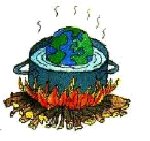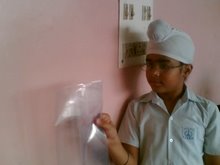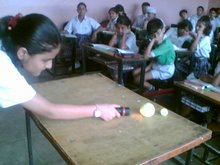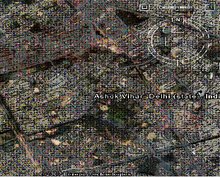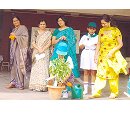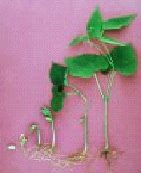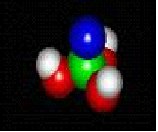whose woods these are i think i know,
his house is in the village though,
he will not see me stopping here,
to watch his woods fill up with snow,
my little horse must think it queer,
to stop without a farmhouse near,
between the woods and frozen lake,
the darkest evening of the year....,
he gives his harness bells a shake,
to ask if there is some mistake.
the only other sound's the sweepof
easy wind and downy flake the woods are lovely dark and deep,
but i have promises to keep,and miles to go before i sleep,
and miles to go before i sleep...............
Friday, 5 October 2007
saving water
Reverse osmosis
Reverse osmosis is a separation process that uses pressure to force a solvent through a membrane retains the solute on one side and allows the pure solvent to pass to the other side.
Water conservation
It refers to reducing use of fresh water through technological or social method as goals.
Drip irrigation
Also known as trickle irrigation or micro-irrigation, is an irrigation method that minimize the use of water and fertilizers by allowing water to drip slowly to the roots of the plants.
Bio gas
It typically refers to a gas produced by the anaerobic digestion or fermentation of organic matter including manure, sewage sludge, municipal solid waste, biodegradable waste under anaerobic condition. It is comprised of carbon-dioxide and methane.
Rain water harvesting
Rainfall water harvesting is the term given to the conservation and storage of rainfall on outcrops and sheets of bare rock helping in managing water scarcity.
Vermicompost
Vermicompost is also known worm compost, worm casting, worm humus or worm manure. It is the end product of the breakdown of organic matter by species of earthworm.
Sewage treatment
It is the process or removing contaminants from waste water, both industrial and domestic. It includes physical, chemicals and biological processes to remove contaminants.
Solar water heater
In order to heat water using solar energy, a collector is fastened to the roof of a building or on a wall facing sun. In some cases, the collector may be tree standing.
Green building
• Eco- friendly paint
• Tiles to facilitate water seepage
• Double layered window glass for insulation
• Temperature control by Evaporating Air Cooling
Water conservation
• Rain water harvesting
• Drip irrigation
• R.O. Plant for purification of water
Garbage reuse & recycling
• Segregation of waste
• Sewage treatment
• Vermicomposting
• Bio gas production
Energy conservation
• Solar water heater
• Solar lights
Reverse osmosis
Reverse osmosis is a separation process that uses pressure to force a solvent through a membrane retains the solute on one side and allows the pure solvent to pass to the other side.
Water conservation
It refers to reducing use of fresh water through technological or social method as goals.
Drip irrigation
Also known as trickle irrigation or micro-irrigation, is an irrigation method that minimize the use of water and fertilizers by allowing water to drip slowly to the roots of the plants.
Bio gas
It typically refers to a gas produced by the anaerobic digestion or fermentation of organic matter including manure, sewage sludge, municipal solid waste, biodegradable waste under anaerobic condition. It is comprised of carbon-dioxide and methane.
Rain water harvesting
Rainfall water harvesting is the term given to the conservation and storage of rainfall on outcrops and sheets of bare rock helping in managing water scarcity.
Vermicompost
Vermicompost is also known worm compost, worm casting, worm humus or worm manure. It is the end product of the breakdown of organic matter by species of earthworm.
Sewage treatment
It is the process or removing contaminants from waste water, both industrial and domestic. It includes physical, chemicals and biological processes to remove contaminants.
Solar water heater
In order to heat water using solar energy, a collector is fastened to the roof of a building or on a wall facing sun. In some cases, the collector may be tree standing.
Green building
• Eco- friendly paint
• Tiles to facilitate water seepage
• Double layered window glass for insulation
• Temperature control by Evaporating Air Cooling
Water conservation
• Rain water harvesting
• Drip irrigation
• R.O. Plant for purification of water
Garbage reuse & recycling
• Segregation of waste
• Sewage treatment
• Vermicomposting
• Bio gas production
Energy conservation
• Solar water heater
• Solar lights
Reverse osmosis
Reverse osmosis is a separation process that uses pressure to force a solvent through a membrane retains the solute on one side and allows the pure solvent to pass to the other side.
Water conservation
It refers to reducing use of fresh water through technological or social method as goals.
Drip irrigation
Also known as trickle irrigation or micro-irrigation, is an irrigation method that minimize the use of water and fertilizers by allowing water to drip slowly to the roots of the plants.
Bio gas
It typically refers to a gas produced by the anaerobic digestion or fermentation of organic matter including manure, sewage sludge, municipal solid waste, biodegradable waste under anaerobic condition. It is comprised of carbon-dioxide and methane.
Rain water harvesting
Rainfall water harvesting is the term given to the conservation and storage of rainfall on outcrops and sheets of bare rock helping in managing water scarcity.
Vermicompost
Vermicompost is also known worm compost, worm casting, worm humus or worm manure. It is the end product of the breakdown of organic matter by species of earthworm.
Sewage treatment
It is the process or removing contaminants from waste water, both industrial and domestic. It includes physical, chemicals and biological processes to remove contaminants.
Solar water heater
In order to heat water using solar energy, a collector is fastened to the roof of a building or on a wall facing sun. In some cases, the collector may be tree standing.
Green building
• Eco- friendly paint
• Tiles to facilitate water seepage
• Double layered window glass for insulation
• Temperature control by Evaporating Air Cooling
Water conservation
• Rain water harvesting
• Drip irrigation
• R.O. Plant for purification of water
Garbage reuse & recycling
• Segregation of waste
• Sewage treatment
• Vermicomposting
• Bio gas production
Energy conservation
• Solar water heater
• Solar lights
Reverse osmosis
Reverse osmosis is a separation process that uses pressure to force a solvent through a membrane retains the solute on one side and allows the pure solvent to pass to the other side.
Water conservation
It refers to reducing use of fresh water through technological or social method as goals.
Drip irrigation
Also known as trickle irrigation or micro-irrigation, is an irrigation method that minimize the use of water and fertilizers by allowing water to drip slowly to the roots of the plants.
Bio gas
It typically refers to a gas produced by the anaerobic digestion or fermentation of organic matter including manure, sewage sludge, municipal solid waste, biodegradable waste under anaerobic condition. It is comprised of carbon-dioxide and methane.
Rain water harvesting
Rainfall water harvesting is the term given to the conservation and storage of rainfall on outcrops and sheets of bare rock helping in managing water scarcity.
Vermicompost
Vermicompost is also known worm compost, worm casting, worm humus or worm manure. It is the end product of the breakdown of organic matter by species of earthworm.
Sewage treatment
It is the process or removing contaminants from waste water, both industrial and domestic. It includes physical, chemicals and biological processes to remove contaminants.
Solar water heater
In order to heat water using solar energy, a collector is fastened to the roof of a building or on a wall facing sun. In some cases, the collector may be tree standing.
Green building
• Eco- friendly paint
• Tiles to facilitate water seepage
• Double layered window glass for insulation
• Temperature control by Evaporating Air Cooling
Water conservation
• Rain water harvesting
• Drip irrigation
• R.O. Plant for purification of water
Garbage reuse & recycling
• Segregation of waste
• Sewage treatment
• Vermicomposting
• Bio gas production
Energy conservation
• Solar water heater
• Solar lights
Reverse osmosis
Reverse osmosis is a separation process that uses pressure to force a solvent through a membrane retains the solute on one side and allows the pure solvent to pass to the other side.
Water conservation
It refers to reducing use of fresh water through technological or social method as goals.
Drip irrigation
Also known as trickle irrigation or micro-irrigation, is an irrigation method that minimize the use of water and fertilizers by allowing water to drip slowly to the roots of the plants.
Bio gas
It typically refers to a gas produced by the anaerobic digestion or fermentation of organic matter including manure, sewage sludge, municipal solid waste, biodegradable waste under anaerobic condition. It is comprised of carbon-dioxide and methane.
Rain water harvesting
Rainfall water harvesting is the term given to the conservation and storage of rainfall on outcrops and sheets of bare rock helping in managing water scarcity.
Vermicompost
Vermicompost is also known worm compost, worm casting, worm humus or worm manure. It is the end product of the breakdown of organic matter by species of earthworm.
Sewage treatment
It is the process or removing contaminants from waste water, both industrial and domestic. It includes physical, chemicals and biological processes to remove contaminants.
Solar water heater
In order to heat water using solar energy, a collector is fastened to the roof of a building or on a wall facing sun. In some cases, the collector may be tree standing.
Green building
• Eco- friendly paint
• Tiles to facilitate water seepage
• Double layered window glass for insulation
• Temperature control by Evaporating Air Cooling
Water conservation
• Rain water harvesting
• Drip irrigation
• R.O. Plant for purification of water
Garbage reuse & recycling
• Segregation of waste
• Sewage treatment
• Vermicomposting
• Bio gas production
Energy conservation
• Solar water heater
• Solar lights
Reverse osmosis
Reverse osmosis is a separation process that uses pressure to force a solvent through a membrane retains the solute on one side and allows the pure solvent to pass to the other side.
Water conservation
It refers to reducing use of fresh water through technological or social method as goals.
Drip irrigation
Also known as trickle irrigation or micro-irrigation, is an irrigation method that minimize the use of water and fertilizers by allowing water to drip slowly to the roots of the plants.
Bio gas
It typically refers to a gas produced by the anaerobic digestion or fermentation of organic matter including manure, sewage sludge, municipal solid waste, biodegradable waste under anaerobic condition. It is comprised of carbon-dioxide and methane.
Rain water harvesting
Rainfall water harvesting is the term given to the conservation and storage of rainfall on outcrops and sheets of bare rock helping in managing water scarcity.
Vermicompost
Vermicompost is also known worm compost, worm casting, worm humus or worm manure. It is the end product of the breakdown of organic matter by species of earthworm.
Sewage treatment
It is the process or removing contaminants from waste water, both industrial and domestic. It includes physical, chemicals and biological processes to remove contaminants.
Solar water heater
In order to heat water using solar energy, a collector is fastened to the roof of a building or on a wall facing sun. In some cases, the collector may be tree standing.
Green building
• Eco- friendly paint
• Tiles to facilitate water seepage
• Double layered window glass for insulation
• Temperature control by Evaporating Air Cooling
Water conservation
• Rain water harvesting
• Drip irrigation
• R.O. Plant for purification of water
Garbage reuse & recycling
• Segregation of waste
• Sewage treatment
• Vermicomposting
• Bio gas production
Energy conservation
• Solar water heater
• Solar lights
Reverse osmosis is a separation process that uses pressure to force a solvent through a membrane retains the solute on one side and allows the pure solvent to pass to the other side.
Water conservation
It refers to reducing use of fresh water through technological or social method as goals.
Drip irrigation
Also known as trickle irrigation or micro-irrigation, is an irrigation method that minimize the use of water and fertilizers by allowing water to drip slowly to the roots of the plants.
Bio gas
It typically refers to a gas produced by the anaerobic digestion or fermentation of organic matter including manure, sewage sludge, municipal solid waste, biodegradable waste under anaerobic condition. It is comprised of carbon-dioxide and methane.
Rain water harvesting
Rainfall water harvesting is the term given to the conservation and storage of rainfall on outcrops and sheets of bare rock helping in managing water scarcity.
Vermicompost
Vermicompost is also known worm compost, worm casting, worm humus or worm manure. It is the end product of the breakdown of organic matter by species of earthworm.
Sewage treatment
It is the process or removing contaminants from waste water, both industrial and domestic. It includes physical, chemicals and biological processes to remove contaminants.
Solar water heater
In order to heat water using solar energy, a collector is fastened to the roof of a building or on a wall facing sun. In some cases, the collector may be tree standing.
Green building
• Eco- friendly paint
• Tiles to facilitate water seepage
• Double layered window glass for insulation
• Temperature control by Evaporating Air Cooling
Water conservation
• Rain water harvesting
• Drip irrigation
• R.O. Plant for purification of water
Garbage reuse & recycling
• Segregation of waste
• Sewage treatment
• Vermicomposting
• Bio gas production
Energy conservation
• Solar water heater
• Solar lights
Reverse osmosis
Reverse osmosis is a separation process that uses pressure to force a solvent through a membrane retains the solute on one side and allows the pure solvent to pass to the other side.
Water conservation
It refers to reducing use of fresh water through technological or social method as goals.
Drip irrigation
Also known as trickle irrigation or micro-irrigation, is an irrigation method that minimize the use of water and fertilizers by allowing water to drip slowly to the roots of the plants.
Bio gas
It typically refers to a gas produced by the anaerobic digestion or fermentation of organic matter including manure, sewage sludge, municipal solid waste, biodegradable waste under anaerobic condition. It is comprised of carbon-dioxide and methane.
Rain water harvesting
Rainfall water harvesting is the term given to the conservation and storage of rainfall on outcrops and sheets of bare rock helping in managing water scarcity.
Vermicompost
Vermicompost is also known worm compost, worm casting, worm humus or worm manure. It is the end product of the breakdown of organic matter by species of earthworm.
Sewage treatment
It is the process or removing contaminants from waste water, both industrial and domestic. It includes physical, chemicals and biological processes to remove contaminants.
Solar water heater
In order to heat water using solar energy, a collector is fastened to the roof of a building or on a wall facing sun. In some cases, the collector may be tree standing.
Green building
• Eco- friendly paint
• Tiles to facilitate water seepage
• Double layered window glass for insulation
• Temperature control by Evaporating Air Cooling
Water conservation
• Rain water harvesting
• Drip irrigation
• R.O. Plant for purification of water
Garbage reuse & recycling
• Segregation of waste
• Sewage treatment
• Vermicomposting
• Bio gas production
Energy conservation
• Solar water heater
• Solar lights
Reverse osmosis
Reverse osmosis is a separation process that uses pressure to force a solvent through a membrane retains the solute on one side and allows the pure solvent to pass to the other side.
Water conservation
It refers to reducing use of fresh water through technological or social method as goals.
Drip irrigation
Also known as trickle irrigation or micro-irrigation, is an irrigation method that minimize the use of water and fertilizers by allowing water to drip slowly to the roots of the plants.
Bio gas
It typically refers to a gas produced by the anaerobic digestion or fermentation of organic matter including manure, sewage sludge, municipal solid waste, biodegradable waste under anaerobic condition. It is comprised of carbon-dioxide and methane.
Rain water harvesting
Rainfall water harvesting is the term given to the conservation and storage of rainfall on outcrops and sheets of bare rock helping in managing water scarcity.
Vermicompost
Vermicompost is also known worm compost, worm casting, worm humus or worm manure. It is the end product of the breakdown of organic matter by species of earthworm.
Sewage treatment
It is the process or removing contaminants from waste water, both industrial and domestic. It includes physical, chemicals and biological processes to remove contaminants.
Solar water heater
In order to heat water using solar energy, a collector is fastened to the roof of a building or on a wall facing sun. In some cases, the collector may be tree standing.
Green building
• Eco- friendly paint
• Tiles to facilitate water seepage
• Double layered window glass for insulation
• Temperature control by Evaporating Air Cooling
Water conservation
• Rain water harvesting
• Drip irrigation
• R.O. Plant for purification of water
Garbage reuse & recycling
• Segregation of waste
• Sewage treatment
• Vermicomposting
• Bio gas production
Energy conservation
• Solar water heater
• Solar lights
Reverse osmosis
Reverse osmosis is a separation process that uses pressure to force a solvent through a membrane retains the solute on one side and allows the pure solvent to pass to the other side.
Water conservation
It refers to reducing use of fresh water through technological or social method as goals.
Drip irrigation
Also known as trickle irrigation or micro-irrigation, is an irrigation method that minimize the use of water and fertilizers by allowing water to drip slowly to the roots of the plants.
Bio gas
It typically refers to a gas produced by the anaerobic digestion or fermentation of organic matter including manure, sewage sludge, municipal solid waste, biodegradable waste under anaerobic condition. It is comprised of carbon-dioxide and methane.
Rain water harvesting
Rainfall water harvesting is the term given to the conservation and storage of rainfall on outcrops and sheets of bare rock helping in managing water scarcity.
Vermicompost
Vermicompost is also known worm compost, worm casting, worm humus or worm manure. It is the end product of the breakdown of organic matter by species of earthworm.
Sewage treatment
It is the process or removing contaminants from waste water, both industrial and domestic. It includes physical, chemicals and biological processes to remove contaminants.
Solar water heater
In order to heat water using solar energy, a collector is fastened to the roof of a building or on a wall facing sun. In some cases, the collector may be tree standing.
Green building
• Eco- friendly paint
• Tiles to facilitate water seepage
• Double layered window glass for insulation
• Temperature control by Evaporating Air Cooling
Water conservation
• Rain water harvesting
• Drip irrigation
• R.O. Plant for purification of water
Garbage reuse & recycling
• Segregation of waste
• Sewage treatment
• Vermicomposting
• Bio gas production
Energy conservation
• Solar water heater
• Solar lights
Reverse osmosis
Reverse osmosis is a separation process that uses pressure to force a solvent through a membrane retains the solute on one side and allows the pure solvent to pass to the other side.
Water conservation
It refers to reducing use of fresh water through technological or social method as goals.
Drip irrigation
Also known as trickle irrigation or micro-irrigation, is an irrigation method that minimize the use of water and fertilizers by allowing water to drip slowly to the roots of the plants.
Bio gas
It typically refers to a gas produced by the anaerobic digestion or fermentation of organic matter including manure, sewage sludge, municipal solid waste, biodegradable waste under anaerobic condition. It is comprised of carbon-dioxide and methane.
Rain water harvesting
Rainfall water harvesting is the term given to the conservation and storage of rainfall on outcrops and sheets of bare rock helping in managing water scarcity.
Vermicompost
Vermicompost is also known worm compost, worm casting, worm humus or worm manure. It is the end product of the breakdown of organic matter by species of earthworm.
Sewage treatment
It is the process or removing contaminants from waste water, both industrial and domestic. It includes physical, chemicals and biological processes to remove contaminants.
Solar water heater
In order to heat water using solar energy, a collector is fastened to the roof of a building or on a wall facing sun. In some cases, the collector may be tree standing.
Green building
• Eco- friendly paint
• Tiles to facilitate water seepage
• Double layered window glass for insulation
• Temperature control by Evaporating Air Cooling
Water conservation
• Rain water harvesting
• Drip irrigation
• R.O. Plant for purification of water
Garbage reuse & recycling
• Segregation of waste
• Sewage treatment
• Vermicomposting
• Bio gas production
Energy conservation
• Solar water heater
• Solar lights
Reverse osmosis
Reverse osmosis is a separation process that uses pressure to force a solvent through a membrane retains the solute on one side and allows the pure solvent to pass to the other side.
Water conservation
It refers to reducing use of fresh water through technological or social method as goals.
Drip irrigation
Also known as trickle irrigation or micro-irrigation, is an irrigation method that minimize the use of water and fertilizers by allowing water to drip slowly to the roots of the plants.
Bio gas
It typically refers to a gas produced by the anaerobic digestion or fermentation of organic matter including manure, sewage sludge, municipal solid waste, biodegradable waste under anaerobic condition. It is comprised of carbon-dioxide and methane.
Rain water harvesting
Rainfall water harvesting is the term given to the conservation and storage of rainfall on outcrops and sheets of bare rock helping in managing water scarcity.
Vermicompost
Vermicompost is also known worm compost, worm casting, worm humus or worm manure. It is the end product of the breakdown of organic matter by species of earthworm.
Sewage treatment
It is the process or removing contaminants from waste water, both industrial and domestic. It includes physical, chemicals and biological processes to remove contaminants.
Solar water heater
In order to heat water using solar energy, a collector is fastened to the roof of a building or on a wall facing sun. In some cases, the collector may be tree standing.
Green building
• Eco- friendly paint
• Tiles to facilitate water seepage
• Double layered window glass for insulation
• Temperature control by Evaporating Air Cooling
Water conservation
• Rain water harvesting
• Drip irrigation
• R.O. Plant for purification of water
Garbage reuse & recycling
• Segregation of waste
• Sewage treatment
• Vermicomposting
• Bio gas production
Energy conservation
• Solar water heater
• Solar lights
Subscribe to:
Comments (Atom)

























